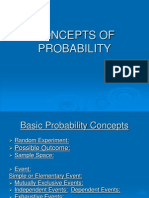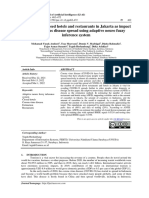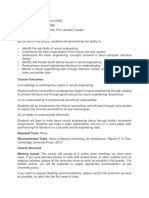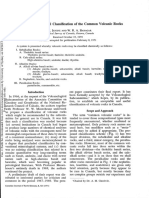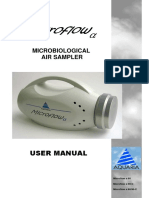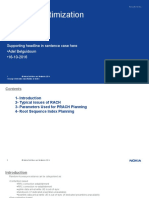Professional Documents
Culture Documents
Determination of The Magneto Hydraulic Pusher's Electromagnet Armature-Piston Attraction Time To The Core Using Mathematical Modeling
Original Title
Copyright
Available Formats
Share this document
Did you find this document useful?
Is this content inappropriate?
Report this DocumentCopyright:
Available Formats
Determination of The Magneto Hydraulic Pusher's Electromagnet Armature-Piston Attraction Time To The Core Using Mathematical Modeling
Copyright:
Available Formats
Volume 6, Issue 3, March – 2021 International Journal of Innovative Science and Research Technology
ISSN No:-2456-2165
Determination of the Magneto Hydraulic Pusher’s
Electromagnet Armature-Piston Attraction Time to
the Core Using Mathematical Modeling
Rusudan Bitsadze Simon Bitsadze
Department of Mathematics Department of Engineering Graphics and
Georgian Technical University Engineering Mechanics
Tbilisi, Georgia Georgian Technical University
Tbilisi, Georgia
Abstract:- Small lifting time of pusher’s rod used as a When two flat surfaces approach each other in the di-
drive gear in vehicles and machinery is one of the key rection of their normal, a thin liquid layer located between
factors of their reliable operation, and increasing the these surfaces acts as a shock-absorber, that’s why a certain
productivity and durability. In its turn, the push rod time is necessary for liquid extrusion. In case of heavy thick-
lifting time depends on both electromagnetic characteris- ness of a liquid layer located between these two surfaces,
tics of pusher’s electromagnet and on those mechanical when these two surfaces approach each other, a resistance to
or hydraulic resistances that are predetermined by their motion is sufficiently small and these two surfaces
design features of the pusher. One of the reasons of push quickly approach each other, while reduction of liquid layer
rod lifting time increment is the resisting force of work thickness causes increase in the liquid extrusion resistance
fluid extrusion situated between the armature-piston and force and the approach velocity of these two surfaces re-
the electromagnet core. In order to make the magneto duces.
hydraulic pusher design even more perfect it is desirable
to determine armature-piston attraction time taking hyd- In case of membrane magneto hydraulic pusher elabo-
raulic resistance into account. In the work there is rated by us [2], when the armature of pusher’s electromagnet
established time distribution of pressure in work fluid attracts to the core, causing the extrusion of a working fluid
area, is calculated the work fluid resistance when arma- located between ring-shaped faces of armature and core, if
ture-piston attracts to the core and there is determined the liquid layer thickness is small, a liquid pressure on the
attraction time with consideration to hydraulic ring surface circles of maximum and minimum radius is
resistance. equal to the magnitude of work chamber pressure. In all
other MHPs elaborated by us [3-7], when armature-piston
Keywords:- Magneto Hydraulic Pusher; Armature-Piston; attracts to the core a liquid is extruded through holes of their
Core; Boundary Conditions; Integration. ring-shape faces. That’s why, in case of liquid extrusion the
fluid pressure at the minimum-radius circles of the ring-
I. INTRODUCTION shape faces equals to the pressure value in the work cham-
ber, i.e. to the minimum pressure in the liquid to be ex-
Different kinds of pushers find manifold use in many truded. In its turn, a liquid pressure at the maximum-radius
industry branches, where there is a necessity of electric pro- circle of the ring-shape face equal to the maximum pressure
cesses transformation into mechanic ones, in particular into in the liquid to be extruded.
rectilinear translation movement [1]. Push rod movement ti-
me when lifting is the important technical characteristic of We set a goal to determine the movement time of ar-
the pusher. mature-piston during attraction, taking into account liquid
extrusion resistance force.
In magneto hydraulic pushers (MHPs) of any design a
MHP electromagnet switches on right after the electric ener- II. MAIN RESULTS
gy supply to pushers, and when electromagnet armature (in
membrane MHP) or armature-piston (in membraneless When armature-piston attracts to the core, the pressure
MHP) completely attracts to the electromagnet core, it squ- P in the liquid located between them can be described by
eezes out the work fluid (oil) situated between them, forces the equation [8]
it into the push rod sub-piston area and lifts push rod by
working stroke value. 2 P 2 P 12 dh
3 , (1)
x 2 y 2 h dt
In case of complete attraction of armature or armature-
piston they fit tightly by upper flat ring-shape butt-end
surface to flat ring-shape butt end of the core and stay in this where – is an process fluid viscosity; h – armature
position unless electricity supply to MHP cuts off. stroke value; t – movement time during armature attraction.
IJISRT21MAR434 www.ijisrt.com 1020
Volume 6, Issue 3, March – 2021 International Journal of Innovative Science and Research Technology
ISSN No:-2456-2165
The following boundary conditions will take place
A0 An cos n Bn sin n
n 1
P r P1 , (2) n
r
Cn cos n Dn sin n
n 1 R
P R P2 , (3) 3 h
C0 ln R 3 R 2 P2 .
h
where the following notation is used
P1 Pmin , A0 , C0 coefficients are determined from the system:
P2 Pmax , 3 h 2 1
2
A0 C0 ln r
h3
r
2 Pd P ,
0
1 1
(7)
is a polar radius, r and R are the small and big radiuses
2
of the ring. If we use polar coordinates: 3 h 2 1
x cos , A0 C0 ln R
h 3
R
2 P d P .
2 2 (8)
0
y sin ,
If we subtract (7) from (8) we obtain that
Equation (1) is written in the following form:
2 P 1 P 1 2 P 12 dh 3 h 2
3 . (4) C0 ln R ln r R r 2 P2 P1 ,
2 2 2 h dt h3
In order to solve the Dirichlet boundary problem (2), from where
3 h 2 2
(3), (4) we note that the general solution of equation is a sum
of general P0 solution of Laplace equation, i.e.
P2 P1
h3
R r
C0 , (9)
corresponding homogenous equation and particular solution ln R ln r
P of Reynolds non-homogenous equation. As is known the
solution of Laplace equation in the collar neighborhood has and taking (7) into account
to be sought in the following form:
3 h 2 2
P2 P1
h3
R r 3 h
n
A0 P1 ln r 3 r 2 . (10)
P0 A0 An cos n Bn sin n ln R ln r h
n 1 R
n
An , Bn , Cn and Dn coefficients are determined by the equ-
r
Cn cos n Dn sin n Co ln . (5) ations
n 1 r n 2
1
An Cn P1 cos n d 0,
R 0
Using a direct verification we will make sure that we can n 2
12 dh 2 r 1
0
take 3 in the role of P . A n C n P2 cos n d 0
h dt 4 R
Thus, the general solution of (4) equation is sought in and
the following form r n 2
1
0 1
n
n B D P sin n d 0,
P0 A0 An cos n Bn sin n
n
R
n 1 R n 2
r 1
n R Dn P2 sin n d 0.
B
r
n
0
Cn cos n Dn sin n
n 1
From these four latter ratios we obtain that
3 h 2 An Bn Cn Dn 0 .
C0 ln . (6)
h3
Thus, the solution of Dirichlet problem for Reynolds
In order that the pressure value in the hydrosystem equation will be of the following form
would satisfy boundary conditions (2), (3), the following
ratios have to be observed based on (4)
IJISRT21MAR434 www.ijisrt.com 1021
Volume 6, Issue 3, March – 2021 International Journal of Innovative Science and Research Technology
ISSN No:-2456-2165
3 h 2 2
R r
Note that when using the partial integration formula
P2 P1
h3 3 h R
R
2
P P1 ln r 3 r 2
ln R ln r h r r
ln d r r d 2
ln
3 h 2 2
P2 P1 3 R r 2
R R
2 r 1
h 3 h ln d
ln 3 2 , 2 r
ln R ln r h r 2 r r
which we re-write as follows R2 R R2 r 2
3 h ln . (13)
P2 P1 3 R 2 r 2 2 r 4
P P1 h ln ln r
ln R ln r Taking (13) into account, from (12) we obtain
F P1 R 2 r 2
3 h 2
h3
r2 . (11) P2 P1 2 R R 2 r 2
R ln
ln R r r 2
3 h R 2 r 2 2 R R 2 r 2
(11) shows the time distribution of pressure along the radius
(from r to R) in the process fluid area to be extruded. R ln
h3 ln R r r 2
In the dimensionless form the (11) equation will be
written as follows
3 h R r
2 2 2
h3 h3 3
P P1 , (14)
hr 2 hr 2 h 2
3 R 1 ln
2
i.e. in dimensionless form
h3 2 1 r
P P ln r r
h3 P1 R
2
h3
F
2 1
h r 2
R R hr 4
hr r
ln ln
r r
2
h P2 P1 R 2 R 1 R 2
3
ln 1
3 1 .
r hr 2 ln R r r r 2 r
The resistance F of the displaced process fluid, when
3 R r 1
2
the armature approaches the core, is calculated via the ring ln R r
D D pressure integration
F P dx dy .
R 2 R 1 R 2 3
2
D R 2
ln 1 1 . (15)
r
r 2 r 2
r
In polar coordinates we will have
F P d d .
D
Now let us re-write (15) in the following form
h F h3 P1 R
3 2
2 1
If we move to multiple integrals, we obtain hr hr r
4
2 R
F P d d
h P2 P1 R 2 R 1 R 2
3
ln 1
hr 2 ln R r r r 2 r
0 r
3 h
P2 P1 3 R 2 r 2
R
R 2
2
2 P1 h ln 3
R 1
r
r
ln
r
2 r
R 2
3 h 3 2 3 1
r R 2 R 1 R 2
3 r d . ln 1
(12)
h ln R r r r 2 r
IJISRT21MAR434 www.ijisrt.com 1022
Volume 6, Issue 3, March – 2021 International Journal of Innovative Science and Research Technology
ISSN No:-2456-2165
from where As h0 we have to take that thickness, in case of which
dt 3 R
2
2
the resistance to movement becomes so sufficient that
1 armature’s retarded motion starts.
dh 2 r
III. CONCLUSION
3 R r 1 R 2 R 1 R 2
2
ln 1
ln R r r
r 2 r
In magneto hydraulic pushers [3-7], for the case of
direct current electromagnet armature-piston attraction to the
core, a resistance force of working fluid extrusion located
F between them is established. Taking this force into account,
P R 2
4 12 1 the armature-piston movement time when pusher’s
r r
r electromagnet armature-piston attracts to the core is
determined. This fact can be used afterwards, when
1 projecting magneto hydraulic pushers design in order to
P P R 2 R 1 R 2 1 improve their characteristics, in particular, for push rod
2 2 1 ln 1 3 . (16)
r ln R r r r 2 r h
lifting time reduction.
REFERENCES
Via integration of (16) equation we obtain a ratio
between time and armature stroke. If armature-piston will [1]. M. P. Aleksandrov, Brakes of carrying and lifting
move from ho to h1, when time changes from to to t1 then machines. Mashinostroenie, 1976.
h1 2 [2]. О. S. Ezikashvili and S. G. Bitsadze, Magneto
3 R
t1 2
dt h 2 r 1 hydraulic pusher. Authorship certificate № 582188,
o
to
USSR, 1977.
[3]. S. Bitsadze and R. Bitsadze, Magneto hydraulic
3 R r 1 R ln R 1 R
2
2
2
pusher. Patent of invention P5536, Georgian Patent,
r 1
2 r
ln R r r 2012.
[4]. S. Bitsadze and R. Bitsadze, Magneto hydraulic
pusher. Patent of invention P5869, Georgian Patent,
2013.
F P R 2
4 12 1 [5]. S. Bitsadze and R. Bitsadze, Magneto hydraulic
r r
r pusher. Patent of invention P6572, Georgian Patent,
2016.
1
[6]. S. Bitsadze and R. Bitsadze, Magneto hydraulic
(P P ) R R 1 R
2
1 2
pusher. Patent of invention P6744, Georgian Patent,
2 2 1 ln 1 3 dh . (17)
r 2 r h 2017.
r ln R r r [7]. S. Bitsadze and R. Bitsadze, Patent of invention P2019
6975B, Georgian Patent, 2019.
Note that the armature attraction force F with an [8]. N. P. Petrov et al., Hydrodynamic theory of
adequate accuracy can be considered as a constant one for lubrication. State Technical and Creative Publisher,
sufficient small h. Based on this fact. Moscow, 1934.
1 1 1 3
2
R 2
t t1 t0 2 2 1
2 ho h1 2
r
3 R r 1 R ln R 1 R
2
2 2
r 1
ln R r r 2 r
F P R
2
4 12 1
r
r r
1
P P R 2 R 1 R 2
2 2 1 ln 1 .
r ln R r r r 2 r
IJISRT21MAR434 www.ijisrt.com 1023
You might also like
- Never Split the Difference: Negotiating As If Your Life Depended On ItFrom EverandNever Split the Difference: Negotiating As If Your Life Depended On ItRating: 4.5 out of 5 stars4.5/5 (838)
- Shoe Dog: A Memoir by the Creator of NikeFrom EverandShoe Dog: A Memoir by the Creator of NikeRating: 4.5 out of 5 stars4.5/5 (537)
- Comparatively Design and Analyze Elevated Rectangular Water Reservoir with and without Bracing for Different Stagging HeightDocument4 pagesComparatively Design and Analyze Elevated Rectangular Water Reservoir with and without Bracing for Different Stagging HeightInternational Journal of Innovative Science and Research TechnologyNo ratings yet
- Diabetic Retinopathy Stage Detection Using CNN and Inception V3Document9 pagesDiabetic Retinopathy Stage Detection Using CNN and Inception V3International Journal of Innovative Science and Research TechnologyNo ratings yet
- The Utilization of Date Palm (Phoenix dactylifera) Leaf Fiber as a Main Component in Making an Improvised Water FilterDocument11 pagesThe Utilization of Date Palm (Phoenix dactylifera) Leaf Fiber as a Main Component in Making an Improvised Water FilterInternational Journal of Innovative Science and Research TechnologyNo ratings yet
- Advancing Healthcare Predictions: Harnessing Machine Learning for Accurate Health Index PrognosisDocument8 pagesAdvancing Healthcare Predictions: Harnessing Machine Learning for Accurate Health Index PrognosisInternational Journal of Innovative Science and Research TechnologyNo ratings yet
- Dense Wavelength Division Multiplexing (DWDM) in IT Networks: A Leap Beyond Synchronous Digital Hierarchy (SDH)Document2 pagesDense Wavelength Division Multiplexing (DWDM) in IT Networks: A Leap Beyond Synchronous Digital Hierarchy (SDH)International Journal of Innovative Science and Research TechnologyNo ratings yet
- Electro-Optics Properties of Intact Cocoa Beans based on Near Infrared TechnologyDocument7 pagesElectro-Optics Properties of Intact Cocoa Beans based on Near Infrared TechnologyInternational Journal of Innovative Science and Research TechnologyNo ratings yet
- Formulation and Evaluation of Poly Herbal Body ScrubDocument6 pagesFormulation and Evaluation of Poly Herbal Body ScrubInternational Journal of Innovative Science and Research TechnologyNo ratings yet
- Terracing as an Old-Style Scheme of Soil Water Preservation in Djingliya-Mandara Mountains- CameroonDocument14 pagesTerracing as an Old-Style Scheme of Soil Water Preservation in Djingliya-Mandara Mountains- CameroonInternational Journal of Innovative Science and Research TechnologyNo ratings yet
- The Impact of Digital Marketing Dimensions on Customer SatisfactionDocument6 pagesThe Impact of Digital Marketing Dimensions on Customer SatisfactionInternational Journal of Innovative Science and Research TechnologyNo ratings yet
- A Review: Pink Eye Outbreak in IndiaDocument3 pagesA Review: Pink Eye Outbreak in IndiaInternational Journal of Innovative Science and Research TechnologyNo ratings yet
- Auto Encoder Driven Hybrid Pipelines for Image Deblurring using NAFNETDocument6 pagesAuto Encoder Driven Hybrid Pipelines for Image Deblurring using NAFNETInternational Journal of Innovative Science and Research TechnologyNo ratings yet
- Design, Development and Evaluation of Methi-Shikakai Herbal ShampooDocument8 pagesDesign, Development and Evaluation of Methi-Shikakai Herbal ShampooInternational Journal of Innovative Science and Research Technology100% (3)
- A Survey of the Plastic Waste used in Paving BlocksDocument4 pagesA Survey of the Plastic Waste used in Paving BlocksInternational Journal of Innovative Science and Research TechnologyNo ratings yet
- Cyberbullying: Legal and Ethical Implications, Challenges and Opportunities for Policy DevelopmentDocument7 pagesCyberbullying: Legal and Ethical Implications, Challenges and Opportunities for Policy DevelopmentInternational Journal of Innovative Science and Research TechnologyNo ratings yet
- Hepatic Portovenous Gas in a Young MaleDocument2 pagesHepatic Portovenous Gas in a Young MaleInternational Journal of Innovative Science and Research TechnologyNo ratings yet
- Explorning the Role of Machine Learning in Enhancing Cloud SecurityDocument5 pagesExplorning the Role of Machine Learning in Enhancing Cloud SecurityInternational Journal of Innovative Science and Research TechnologyNo ratings yet
- Navigating Digitalization: AHP Insights for SMEs' Strategic TransformationDocument11 pagesNavigating Digitalization: AHP Insights for SMEs' Strategic TransformationInternational Journal of Innovative Science and Research TechnologyNo ratings yet
- Perceived Impact of Active Pedagogy in Medical Students' Learning at the Faculty of Medicine and Pharmacy of CasablancaDocument5 pagesPerceived Impact of Active Pedagogy in Medical Students' Learning at the Faculty of Medicine and Pharmacy of CasablancaInternational Journal of Innovative Science and Research TechnologyNo ratings yet
- Automatic Power Factor ControllerDocument4 pagesAutomatic Power Factor ControllerInternational Journal of Innovative Science and Research TechnologyNo ratings yet
- Mobile Distractions among Adolescents: Impact on Learning in the Aftermath of COVID-19 in IndiaDocument2 pagesMobile Distractions among Adolescents: Impact on Learning in the Aftermath of COVID-19 in IndiaInternational Journal of Innovative Science and Research TechnologyNo ratings yet
- Review of Biomechanics in Footwear Design and Development: An Exploration of Key Concepts and InnovationsDocument5 pagesReview of Biomechanics in Footwear Design and Development: An Exploration of Key Concepts and InnovationsInternational Journal of Innovative Science and Research TechnologyNo ratings yet
- Studying the Situation and Proposing Some Basic Solutions to Improve Psychological Harmony Between Managerial Staff and Students of Medical Universities in Hanoi AreaDocument5 pagesStudying the Situation and Proposing Some Basic Solutions to Improve Psychological Harmony Between Managerial Staff and Students of Medical Universities in Hanoi AreaInternational Journal of Innovative Science and Research TechnologyNo ratings yet
- The Effect of Time Variables as Predictors of Senior Secondary School Students' Mathematical Performance Department of Mathematics Education Freetown PolytechnicDocument7 pagesThe Effect of Time Variables as Predictors of Senior Secondary School Students' Mathematical Performance Department of Mathematics Education Freetown PolytechnicInternational Journal of Innovative Science and Research TechnologyNo ratings yet
- Drug Dosage Control System Using Reinforcement LearningDocument8 pagesDrug Dosage Control System Using Reinforcement LearningInternational Journal of Innovative Science and Research TechnologyNo ratings yet
- Securing Document Exchange with Blockchain Technology: A New Paradigm for Information SharingDocument4 pagesSecuring Document Exchange with Blockchain Technology: A New Paradigm for Information SharingInternational Journal of Innovative Science and Research TechnologyNo ratings yet
- Enhancing the Strength of Concrete by Using Human Hairs as a FiberDocument3 pagesEnhancing the Strength of Concrete by Using Human Hairs as a FiberInternational Journal of Innovative Science and Research TechnologyNo ratings yet
- Formation of New Technology in Automated Highway System in Peripheral HighwayDocument6 pagesFormation of New Technology in Automated Highway System in Peripheral HighwayInternational Journal of Innovative Science and Research TechnologyNo ratings yet
- Supply Chain 5.0: A Comprehensive Literature Review on Implications, Applications and ChallengesDocument11 pagesSupply Chain 5.0: A Comprehensive Literature Review on Implications, Applications and ChallengesInternational Journal of Innovative Science and Research TechnologyNo ratings yet
- Intelligent Engines: Revolutionizing Manufacturing and Supply Chains with AIDocument14 pagesIntelligent Engines: Revolutionizing Manufacturing and Supply Chains with AIInternational Journal of Innovative Science and Research TechnologyNo ratings yet
- The Making of Self-Disposing Contactless Motion-Activated Trash Bin Using Ultrasonic SensorsDocument7 pagesThe Making of Self-Disposing Contactless Motion-Activated Trash Bin Using Ultrasonic SensorsInternational Journal of Innovative Science and Research TechnologyNo ratings yet
- The Subtle Art of Not Giving a F*ck: A Counterintuitive Approach to Living a Good LifeFrom EverandThe Subtle Art of Not Giving a F*ck: A Counterintuitive Approach to Living a Good LifeRating: 4 out of 5 stars4/5 (5794)
- The Yellow House: A Memoir (2019 National Book Award Winner)From EverandThe Yellow House: A Memoir (2019 National Book Award Winner)Rating: 4 out of 5 stars4/5 (98)
- Hidden Figures: The American Dream and the Untold Story of the Black Women Mathematicians Who Helped Win the Space RaceFrom EverandHidden Figures: The American Dream and the Untold Story of the Black Women Mathematicians Who Helped Win the Space RaceRating: 4 out of 5 stars4/5 (894)
- The Little Book of Hygge: Danish Secrets to Happy LivingFrom EverandThe Little Book of Hygge: Danish Secrets to Happy LivingRating: 3.5 out of 5 stars3.5/5 (399)
- Elon Musk: Tesla, SpaceX, and the Quest for a Fantastic FutureFrom EverandElon Musk: Tesla, SpaceX, and the Quest for a Fantastic FutureRating: 4.5 out of 5 stars4.5/5 (474)
- A Heartbreaking Work Of Staggering Genius: A Memoir Based on a True StoryFrom EverandA Heartbreaking Work Of Staggering Genius: A Memoir Based on a True StoryRating: 3.5 out of 5 stars3.5/5 (231)
- Grit: The Power of Passion and PerseveranceFrom EverandGrit: The Power of Passion and PerseveranceRating: 4 out of 5 stars4/5 (587)
- Devil in the Grove: Thurgood Marshall, the Groveland Boys, and the Dawn of a New AmericaFrom EverandDevil in the Grove: Thurgood Marshall, the Groveland Boys, and the Dawn of a New AmericaRating: 4.5 out of 5 stars4.5/5 (266)
- On Fire: The (Burning) Case for a Green New DealFrom EverandOn Fire: The (Burning) Case for a Green New DealRating: 4 out of 5 stars4/5 (73)
- The Emperor of All Maladies: A Biography of CancerFrom EverandThe Emperor of All Maladies: A Biography of CancerRating: 4.5 out of 5 stars4.5/5 (271)
- The Hard Thing About Hard Things: Building a Business When There Are No Easy AnswersFrom EverandThe Hard Thing About Hard Things: Building a Business When There Are No Easy AnswersRating: 4.5 out of 5 stars4.5/5 (344)
- The Unwinding: An Inner History of the New AmericaFrom EverandThe Unwinding: An Inner History of the New AmericaRating: 4 out of 5 stars4/5 (45)
- Team of Rivals: The Political Genius of Abraham LincolnFrom EverandTeam of Rivals: The Political Genius of Abraham LincolnRating: 4.5 out of 5 stars4.5/5 (234)
- The World Is Flat 3.0: A Brief History of the Twenty-first CenturyFrom EverandThe World Is Flat 3.0: A Brief History of the Twenty-first CenturyRating: 3.5 out of 5 stars3.5/5 (2219)
- The Gifts of Imperfection: Let Go of Who You Think You're Supposed to Be and Embrace Who You AreFrom EverandThe Gifts of Imperfection: Let Go of Who You Think You're Supposed to Be and Embrace Who You AreRating: 4 out of 5 stars4/5 (1090)
- The Sympathizer: A Novel (Pulitzer Prize for Fiction)From EverandThe Sympathizer: A Novel (Pulitzer Prize for Fiction)Rating: 4.5 out of 5 stars4.5/5 (119)
- Her Body and Other Parties: StoriesFrom EverandHer Body and Other Parties: StoriesRating: 4 out of 5 stars4/5 (821)
- Desing Criteria For A Controlled DemolitionDocument12 pagesDesing Criteria For A Controlled Demolitionajmc1No ratings yet
- Concepts of ProbabilityDocument32 pagesConcepts of ProbabilityRushina SinghiNo ratings yet
- Estimation of Closed Hotels and Restaurants in Jakarta As Impact of Corona Virus Disease Spread Using Adaptive Neuro Fuzzy Inference SystemDocument11 pagesEstimation of Closed Hotels and Restaurants in Jakarta As Impact of Corona Virus Disease Spread Using Adaptive Neuro Fuzzy Inference SystemIAES IJAINo ratings yet
- B10 GeniE Member Plate Code CheckingDocument51 pagesB10 GeniE Member Plate Code CheckingJorge HLNo ratings yet
- Environmental Modifications: Nakul RangaDocument42 pagesEnvironmental Modifications: Nakul Rangataniamahapatra1No ratings yet
- Braithwaite 2017 Complexity Science in Healthcare A White PaperDocument129 pagesBraithwaite 2017 Complexity Science in Healthcare A White PaperFinga Hitam ManiesNo ratings yet
- 2500 Supreme IO&M ManualDocument36 pages2500 Supreme IO&M Manualadrianram1No ratings yet
- Syllabus 2020Document4 pagesSyllabus 2020asdfghjklNo ratings yet
- La Villa Fact Sheet 2021-2022-UpdatedDocument4 pagesLa Villa Fact Sheet 2021-2022-Updatedsweta suresh ganvirNo ratings yet
- A Guide to Chemical Classification of Common Volcanic RocksDocument26 pagesA Guide to Chemical Classification of Common Volcanic RocksPepeeJh VaargasNo ratings yet
- Lesson 3 - Charle's LawDocument11 pagesLesson 3 - Charle's LawJoanNo ratings yet
- 23 Section I GW Glasses Window System and MirrorsDocument58 pages23 Section I GW Glasses Window System and Mirrorsamir8100No ratings yet
- Copper Alloy UNS C23000: Sponsored LinksDocument2 pagesCopper Alloy UNS C23000: Sponsored LinksvinayNo ratings yet
- Briarborn - Nature's ProtectorsDocument6 pagesBriarborn - Nature's Protectorsa1057soulNo ratings yet
- Manual Liebert PSADocument12 pagesManual Liebert PSAMatthew CannonNo ratings yet
- Quiz 2 AnswersDocument6 pagesQuiz 2 Answerselliott.rillstoneNo ratings yet
- Computer Integrated ManufacturingDocument7 pagesComputer Integrated ManufacturingNarendra PalacharlaNo ratings yet
- Range Safety Regulations and DocumentsDocument11 pagesRange Safety Regulations and Documentsjakehunter24No ratings yet
- TD Polyfloor-SealerDocument12 pagesTD Polyfloor-SealerDhani RamadhanNo ratings yet
- Microflow Air Sampler User ManualDocument31 pagesMicroflow Air Sampler User Manualira rahmaNo ratings yet
- Basics For BJJ SC - V3Document20 pagesBasics For BJJ SC - V3Teo Tolo100% (2)
- IBPhysics Particle Practice KeyDocument2 pagesIBPhysics Particle Practice KeyOnur YavuzcetinNo ratings yet
- Process Flow ChartDocument4 pagesProcess Flow Chartchacko chiramalNo ratings yet
- PRACH Optimization - V1Document11 pagesPRACH Optimization - V1Tulipe Pivoine100% (5)
- Bsczo 201Document280 pagesBsczo 201ishfaqqqNo ratings yet
- Discount Rate - Environmental EconomicsDocument6 pagesDiscount Rate - Environmental EconomicsRoberta DGNo ratings yet
- Environmental AuditingDocument27 pagesEnvironmental Auditinghitman agent 47No ratings yet
- Power Gating - Power Management Technique: VLSI Basics and Interview QuestionsDocument12 pagesPower Gating - Power Management Technique: VLSI Basics and Interview QuestionsRohith RajNo ratings yet
- ACS Sainsbury and Asda Merger Leaner 82Document26 pagesACS Sainsbury and Asda Merger Leaner 82FlareGBANo ratings yet
- Final QuesDocument5 pagesFinal QuesMani KumarNo ratings yet








































































